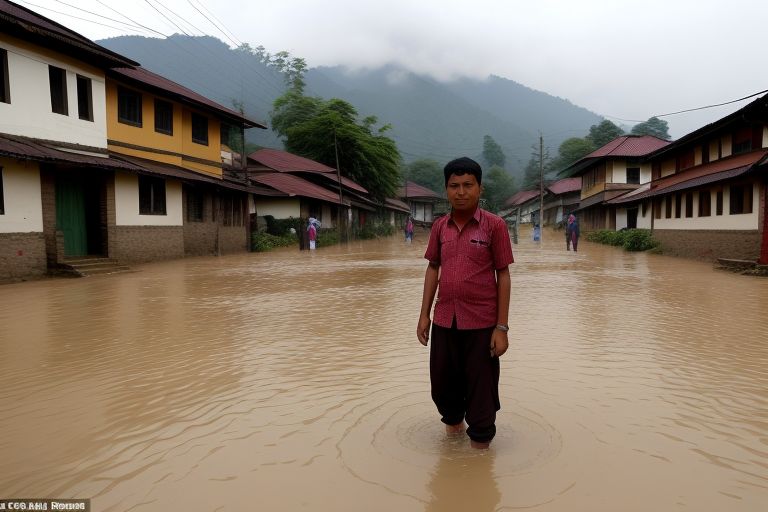The rains that are sweeping through Nepal are part floods, part cyclones, and part cloudbursts, and the country is drowning, literally. Kathmandu valley especially the capital city of nepal has been devastated,due to the flash floods and landslides that were caused by the unusually heavy rainfall. The number of casualties continues to grow and thousands of residents are affected, protests against the government and increased demand for its activities regarding disaster management, road construction, and urbanization.
Kathmandu dwellers woke up to their roads and houses flooded due to the highest level of rainfall the city has seen in three and half decades. Bagmati River that flows in and around the capital city has posed a major threat to non-structural areas as it is flooding at its banks in some black zones. Civil administrations have been trying their best to help detained people to leave their houses, especially districts in high risk, but the flood is huge and is causing enorrmous deficit in treatments.
It affects various sections of communities, not only the dense population centers. Road access to many rural parts in Nepal has been blocked by landslides and washed out, which is complicating the rescue and relief mission. In the hilly area, several houses have been covered with mud and other debris and with several villages wiped out altogether, the search and rescue operations are difficult in such areas. The Nepal Army has been mobilized to help in the rescue and relief efforts, moving food supplies and people in and out by helicopters while they are still in the danger zone.
The government has been criticized for not doing enough to prepare for the disaster even though meteorologists have been warning the public that this year’s monsoon is going to be severe. Opposition parties have urged an emergency House sitting to discuss on the tragedy and provide more funds for rescue and rehabilitation. The Prime Minister has urged the public to remain peace and calm and at the same time informed that all precautionary measures are being taken and efforts are being made for the help of the flood victims.
Another factor of major concern following the flooding is the condition of roads in Nepal today. Poor highway designs and poor maintenance practices over the years have made many highways and rural roads susceptible to weather damage. The current disaster has availed challenges with major communication and transport channels in the country being rendered off limits. Besides disrupting humanitarian operations, it has also led to apprehension as to how a poor infrastructure base is going to sustain Nepal’s future economic growth and development.
The Ministry of Physical Infrastructure and Transport has been criticized for its inability to ensure and preserve the roads for the monsoon season. It has been claimed that while budgets are set every year for improving roads, most of the projects are not going to be completed on time of are poorly done. The government has promised that a wide scale reform of road construction and maintenance procedures will be made, as soon as the current situation stabilizes.
The situation is worsening with every drop of rain as the health sector takes its time to warn of possible diseases outbreaks within the affected regions. Food scarcity with rotten stocks and spoiled crops, as well as spoiled water sources and affected sanitation measures, increases the likelihood of various water borne diseases to erupt in the affected areas especially amidst the IDP camps. The ministry of health has deployed doctors and nurses and equipments and are operating from the relief centers to attend to the affected health wise, While planning to distribute just released water tabets and other necessities.
The agricultural industry is one of Nepal’s pillars, and it has also felt the brunt of the monsoon destruction. Many areas of agricultural fields are flooded and crops, together with animals are drowned. This is expected to affect food security and rural incomes in the coming months in a big way. The government has proposed an urgent contingency fund for agriculture but farmers organizations have indicated that much more will be required to revive agriculture.
While the Nepali government and population wrestle with this near-term challenge, there is increasing awareness of the desirability of implementing measures for building resilience to climate change in the longer term. According to climate specialists, such calamities are expected to recur more often or be more severe because of global climate change. This made calls for more funding for climate proof structures and disaster preparedness at community, county, state and national levels.
The authorities of other countries and international organizations have reacted to the situation in Nepal, several countries and international organizations expressed their willingness to help. Although, the extent of destruction has indicated that the recovery process will probably take several months if not years. While the floods abate and the populations end up in search for relief items, and physical infrastructure to the loss incurred due to floods, the process of reconstructing Nepal will have to embark on more than just constructing the remaining investment in physical capital from structures and infrastructures that have been destroyed by floods but also trying to striving how to cope with the future shocks of climate change that looks inevitable as the climate changes.


